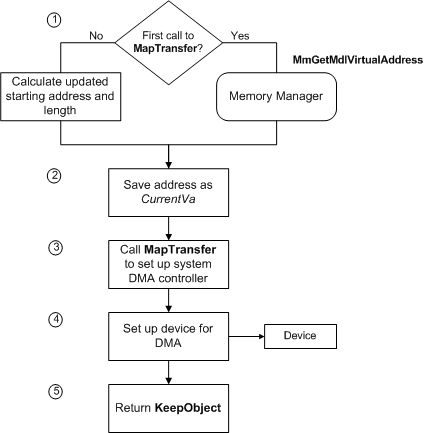Note
Access to this page requires authorization. You can try signing in or changing directories.
Access to this page requires authorization. You can try changing directories.
When AllocateAdapterChannel transfers control to a driver's AdapterControl routine, the driver "owns" the system DMA controller and a set of map registers. Then, the driver must set up the DMA controller for a transfer operation, as shown in the following figure.

If the driver has a StartIo routine, AllocateAdapterChannel passes a pointer to DeviceObject->CurrentIrp in the PIrp parameter to the AdapterControl routine. If, however, the driver manages its own queue of IRPs, the driver should include a pointer to the current IRP as part of the context it passes to AdapterControl.
As the previous figure shows, the driver's AdapterControl routine sets up the DMA transfer, as follows:
The AdapterControl routine gets the address at which to start the transfer. For the initial transfer required to satisfy an IRP, the AdapterControl routine calls MmGetMdlVirtualAddress, passing a pointer to the MDL at Irp->MdlAddress, which describes the buffer for this DMA transfer.
MmGetMdlVirtualAddress returns a virtual address that the driver can use as an index for the system physical address where the transfer should start.
If the IRP requires more than one transfer operation, the driver calculates an updated starting address, as described later in this section.
The AdapterControl routine saves the address returned by MmGetMdlVirtualAddress or calculated in step 1. This address is a required parameter (CurrentVa) to MapTransfer.
The AdapterControl routine calls MapTransfer to set up the system DMA controller, supplying the following parameters:
The adapter object pointer returned by IoGetDmaAdapter
A pointer (Mdl) to the MDL at Irp->MdlAddress for the current IRP
The MapRegisterBase handle passed to the driver's AdapterControl routine by AllocateAdapterChannel
The value (CurrentVa) returned by MmGetMdlVirtualAddress if this is the first call to MapTransfer for the IRP
Otherwise, the driver supplies an updated CurrentVa value, indicating where in the buffer the next transfer operation should start.
A pointer to a variable (Length) indicating the number of bytes for this transfer
If the driver can transfer all the requested data with a single call to MapTransfer and has no device-specific constraints on its DMA operations, Length can be set to the value of Length in the driver's I/O stack location of the IRP. At most, the length in bytes can be (PAGE_SIZE * the NumberOfMapRegisters returned by IoGetDmaAdapter). Otherwise, the driver must split up the request, as explained in Splitting Transfer Requests, and must update the value of Length in subsequent calls to MapTransfer for the current IRP.
A Boolean value (WriteToDevice), indicating the direction of the transfer operation (TRUE to transfer data from system memory to the device)
MapTransfer returns a logical address. Drivers that use system DMA must ignore this value.
The AdapterControl routine sets up the device for the DMA operation.
The AdapterControl routine returns KeepObject.
When the device indicates that its current DMA operation has completed, the driver should call FlushAdapterBuffers, usually from the driver's DpcForIsr routine.
The DpcForIsr routine or another driver routine that completes a DMA operation calls FlushAdapterBuffers to ensure that any data cached in the system DMA controller is read into system memory or written out to the device. The same routine also must call MapTransfer again if it is necessary to reprogram the system DMA controller to transfer more data for the current IRP. Similarly, it must call FlushAdapterBuffers again following each transfer operation.
If a driver must call MapTransfer more than once for the current IRP, it supplies the same adapter object pointer, Mdl pointer, MapRegisterBase handle, and transfer direction in every call. However, the driver must update the CurrentVa and Length parameters before it makes the second and any subsequent calls to MapTransfer. To calculate an updated value for each of these parameters, use the following formulas:
CurrentVa = CurrentVa + (Length requested in the preceding call to MapTransfer)
Length = Minimum (remaining Length to be transferred, (PAGE_SIZE * NumberOfMapRegisters returned by IoGetDmaAdapter))
The context information each driver should maintain about its DMA transfers depends on the needs of its particular device. Typical context might include the current virtual address in the MDL (CurrentVa), the number of bytes transferred so far, the number of bytes remaining to transfer, possibly a pointer to the current IRP, and any other information the driver writer deems useful.
When the requested transfer is complete, or if the driver must return an error status for the IRP, the driver should call FreeAdapterChannel promptly to release the system DMA controller for other drivers and this driver to use.